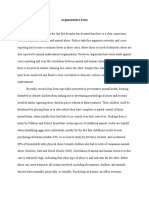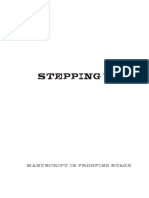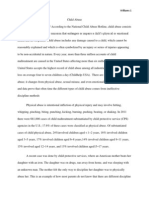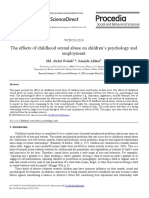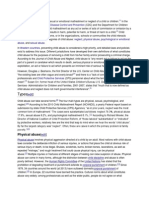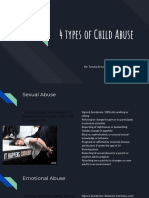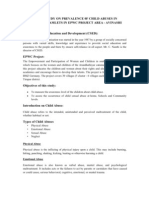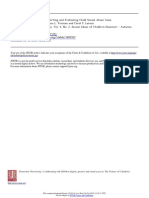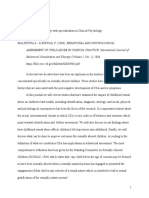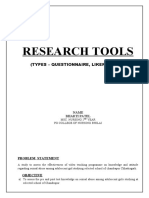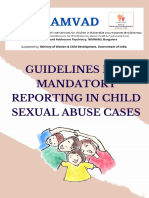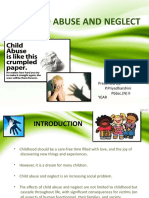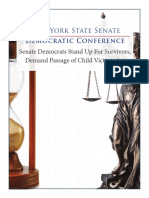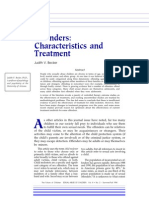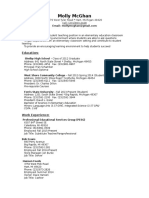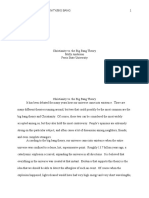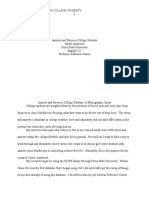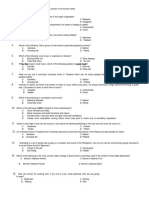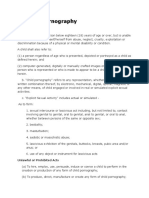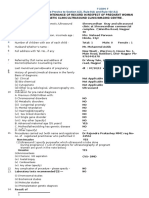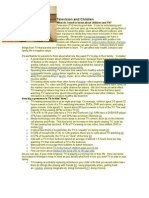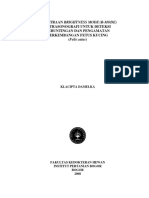Research Paper - Child Abuse
Research Paper - Child Abuse
Uploaded by
api-305904597Copyright:
Available Formats
Research Paper - Child Abuse
Research Paper - Child Abuse
Uploaded by
api-305904597Original Title
Copyright
Available Formats
Share this document
Did you find this document useful?
Is this content inappropriate?
Copyright:
Available Formats
Research Paper - Child Abuse
Research Paper - Child Abuse
Uploaded by
api-305904597Copyright:
Available Formats
Anderson 1
Molly Anderson
Jan Webb
English 112-52
27 February 2013
The Pain that Follows
Five children die every day due to abuse. Approximately 80 percent of
children that die from abuse are under the age of 4. Every year roughly 3
million child abuse cases are reported, involving nearly 6 million children.
The definition of Child Abuse, according to the San Francisco Child Abuse
Prevention Center is any act that endangers a childs physical or emotional
health and development. There are various kinds of Child Abuse, including:
emotional, physical, and sexual abuse. Although these types of abuse are
labeled differently, all of them contain long-lasting physical and emotional
effects. These effects can consume someones life, even after years of the
abuse has stopped.
I should be dead now from the things that were done to me. I truly
believe it is because of God that I am still here, (Childhelp). This quote
comes from a man named Ron, who is still experiencing the long-term effects
of abuse. By his friendly personality, and his average life, no one would
know that for almost 15 years he was neglected, abused and molested. The
abuse began during bath time when Ron was very little. His mother would
Anderson 2
hold a bath towel over his mouth until he begged her to stop. She would
then remove the towel, but do it over and over again, during the course of
bath time. In then became a part of his everyday life, when his mom put a
padlock on his bedroom door and would lock him in his room for hours on
end. Ron was even forced to relieve himself on the floor, when his mother
would not let him out. It wasnt just the physical abuse he received from his
mother, though. She would curse at him, and tell him that he wasnt his
fathers son. Rons everyday life consisted of sleeping in the car and digging
for food out of the trash.
Ron was one of 5 children, so the abuse didnt begin and end with him.
His two youngest siblings never received any neglect or abuse, but Ron
along with his two older siblings did. Wed be in bed and hear my mother
walking in the hallway and pray that she wasnt coming to get us, Ron says,
(Childhelp). What a horrible way to live life; constantly anticipating the cruel
abuse from a mother who is supposed to love and care for her children.
Ron was moved to various family members houses, but time and time
again, he would always end up back living at his parents house. By the time
he was 13, he finally was free of his mother, but unfortunately, that didnt
necessarily bring peace to his life. Ron was living with his 20 year-old cousin,
and a friend of his cousins was constantly found hanging out in the
apartment. The cousins friend was roughly 300 pounds and bullied Ron to
the point of even touching his genitals sometimes, (Childhelp). This friend
Anderson 3
and Rons cousin knew that he had come from a broken home and that he
didnt have anywhere to run, or anyone to tell about how they treated him.
Ron had already experienced the abuse of a lifetime, but one day he
was subjected to the most horrific thing he would ever experience. Ron and
his cousin went to go visit the cousins friend at the gas station he worked at,
across the street from their apartment. Saying that things got out of hand
was an understatement. His cousin then proceeded to pull Rons pants down
and spread his ankles apart. The friend then sodomized Ron with an air hose
that was used to put air into tires. Ron began spitting out vast amounts of
blood, and his gallbladder and appendix were damaged so severely that they
had to be removed, (Childhelp). According to the doctors, Ron shouldnt
have even survived from this tragic event. Ron now suffers from health
issues including the requirement of wearing an adult diaper during any
strenuous activity, and seeing a therapist each week, to cope with the
mental and emotional scars of his abuse, (Childhelp).
This horrific story is a detailed description of the long-lasting effects of
abuse. The abuse continued on for years, and even now, after its all over,
he is reminded everyday by the tragic events that took place in his past. Not
only is he mentally and emotionally reminded me, but also by the physical
scars that he was given. What Ron experienced may have been avoided if
he was able to get help. Ron believes that the key to ending is abuse is
telling someone, (Childhelp). It can be hard to trust someone, when one is
Anderson 4
experiencing such traumatic events, because he/she is afraid that someone
will tell the wrong person and that they will receive that much more abuse.
Rons various family members knew he was getting abused but didnt say
anything, for fear of getting their own family into trouble. This is true for
many people who are aware of abuse happening around them, and it is truly
heartbreaking. The world we live in today is selfish, and only ever worried
about their well-being and reputation.
Not only are there the physical effects as in Rons story, but the most
major effects are usually the emotional effects. Babies with mildly severe
emotional deprivation can become insecure children that are slow to
develop. Much of the time, the visible signs of emotional abuse can go
undetected. The hidden scares of this type of abuse manifest in numerous
behavioral way, including insecurity, poor self-esteem, destructive behavior,
angry acts (such as fire setting and animal cruelty), withdrawal, poor
development of basic skills, alcohol or drug abuse, suicide, difficulty forming
relationships and unstable job histories, (American Humane Association).
This list accurately describes many of the long-term emotional effects of
child abuse. Not only does the child suffer from the effects of the abuse, but
other people around them can too. For example, the list contained
destructive behavior, and angry acts. Both of these harm the emotionally
abused child, as well as the people that come in contact with that child. This
directly proves why the long-lasting effects of child abuse are crucial and
Anderson 5
relevant to the entire world. These abused children need help from all
around the world, especially the community they live in.
A question that people might ask is, Who is able to say what should
be considered child abuse, and what shouldnt be? This is a hard question
to answer, because there is a fine line between disciplining a child and
abusing a child. According to the American Humane Association, physical
discipline is an inappropriate form of disciplining children. Disciplining by
spanking does not facilitate learning. Instead, it may halt the unwanted
behavior only while the child is in the adults presence, or it may scare a
child into submission, (American Humane Association). I believe that there
is some truth to this statement, but not to the point where physical discipline
(spanking, striking, etc.) should be completely opposed. It does often scare
a child into submission, but that isnt always a negative effect. Children
should feel that they live in a safe and loving environment, but should have a
sort of fear or respect for their parents and care takers. The American
Humane Association also states that physical discipline (spanking, striking,
etc.) fills a child with anxiety, directly relating to the fear. The anxiety that
overcomes a child before being physically disciplined is a part of the whole
process. That piece of nervousness is sometimes more effective discipline
than the actual spanking or striking. It reminds them to think more carefully
next time, before they display the bad behavior. While it may teach a child
what not to do, it fails to teach a child what is expected of him or her and
what is an alternate behavior, (American Humane Association). I find this
Anderson 6
statement to be partially true, in the fact that parents should not just
physically discipline there child without explaining to them why they are
getting in trouble, and what they did to deserve it. Physical discipline isnt
just about slapping a child across the face, or spanking him/her when a
parent is upset, its about helping make the connection between the bad
behavior and the physical pain he/she feels. Physical discipline is not an
inappropriate form of discipline, unless it is not followed by communication
between the parent and the child about why the discipline had to take place.
The list of emotional effects goes on and on when children are inflicted
with any and all types of abuse. According to the South China Morning Post,
60 percent of adults seeking counseling for emotional or family problems,
through Caritas Family Services, had been sexually abused as a child.
Twelve percent said that as a child they had been coerced into sexual
intercourse by an adult, and a quarter of those abused said they had suffered
unwanted touching or fondling by adults, (South China Morning Post).
Although these percentages may seem low, that is still hundreds and
thousands of children that are being put through abuse on a daily basis. The
effects are not always short, and slim to none go unscathed by the sexual,
physical or emotional abuse they endured.
Adults are leading insecure lives today due to the long-lasting effects
of Child Abuse. The fine lines between discipline and abuse make it difficult
for children to be rescued from these harmful environments. Communities
Anderson 7
need to always keep their eyes open, and heart strong to stand up for these
children who so badly need to be protected from the effects of abuse.
Physical, sexual or emotional, all these forms of abuse will play a major role
in someones life, as they grow up. The act of Child Abuse needs to be
stopped before it can even begin.
Works Cited
American Humane Association. "Emotional Abuse. American Humane
Association, 2013. Web. 6 March 2013.
<http://www.americanhumane.org/children/stop-child-abuse/factsheets/emotional-abuse.html>.
Anderson 8
American Humane Association. Child Discipline. American Humane
Association, 2013. Web. 6 March 2013.
<http://www.americanhumane.org/children/stop-child-abuse/factsheets/child-discipline.html>.
Childhelp. National Child Abuse Statistics. Childhelp, 1959-2013. Web.
27 February 2013. <http://www.childhelp.org/pages/statistics>.
Childhelp. Neglected, Abused, and Molested; Ron Couldnt Escape.
Childhelp, 1959-2013. Web. 27 February 2013.
<http://www.childhelp.org/stories/entry/neglected-abused-andmolested-ron-couldnt-escape1/>.
Rhonda Lam, W. A. N. (1996, Apr 02). Survey reveals child abuse effects.
South China Morning Post. Retrieved from
http://search.proquest.com.ezproxy.gvsu.edu/docview/265308980?
accountid=39473
San Francisco Child Abuse Prevention Center. Information About Child
Abuse & Prevention. San Francisco Child Abuse Prevention Center,
2011-2013. Web. 27 February 2013.
<http://sfcapc.org/press_room/information_about_child_abuse_and_pre
vention?gclid=CNujhtWn17UCFa9aMgod9wMAIw>.
You might also like
- Argumentative Essay Animal and Domestic AbuseDocument7 pagesArgumentative Essay Animal and Domestic Abuseapi-316529460100% (1)
- Courageous SteppingUpDocument40 pagesCourageous SteppingUpSairam SatguruNo ratings yet
- An Invisible Crime and Shattered InnocenceDocument6 pagesAn Invisible Crime and Shattered InnocencejensonloganNo ratings yet
- One in Seven Children of Secondary School Age in The Maldives, Sexually AbusedDocument2 pagesOne in Seven Children of Secondary School Age in The Maldives, Sexually AbusedwalliullahbukhariNo ratings yet
- Delusion DamageDocument559 pagesDelusion DamageEsther Vilar Masculinisme100% (1)
- MSF HIV-TB Clinical Guide EnglishDocument365 pagesMSF HIV-TB Clinical Guide EnglishAhmed Dbb100% (2)
- Child Abuse Research PaperDocument9 pagesChild Abuse Research Paperapi-246003989No ratings yet
- Black and Blue-The Cycle of Child Abuse 2Document10 pagesBlack and Blue-The Cycle of Child Abuse 2api-300734754No ratings yet
- The Murder of Jeffrey Dryden: The Grim Truth Surrounding Male Domestic AbuseFrom EverandThe Murder of Jeffrey Dryden: The Grim Truth Surrounding Male Domestic AbuseRating: 4 out of 5 stars4/5 (1)
- Human Abuse and TreatmentDocument5 pagesHuman Abuse and TreatmentLETISIA FATUMANo ratings yet
- Child AbuseDocument24 pagesChild Abuseapi-357231993No ratings yet
- Paper FinalDocument21 pagesPaper Finalapi-316872041No ratings yet
- Teaching Children To Protect Themselves From Sexual AbuseDocument10 pagesTeaching Children To Protect Themselves From Sexual AbusenicajoseNo ratings yet
- Article 2 - Child AbuseDocument3 pagesArticle 2 - Child AbuseFaiz FahmiNo ratings yet
- Child Sexual Abuse in The Etiology of DepressionDocument12 pagesChild Sexual Abuse in The Etiology of DepressionMaríaPaz CollellNo ratings yet
- Drawings in Forensic Investigations of Child Sexual AbuseDocument16 pagesDrawings in Forensic Investigations of Child Sexual AbuseMira HanafiNo ratings yet
- The Missing Children in Public Discourse On Child Sexual AbuseDocument8 pagesThe Missing Children in Public Discourse On Child Sexual AbuseJane Gilgun100% (1)
- The Effects of Childhood Sexual Abuse On Children's Psychology andDocument6 pagesThe Effects of Childhood Sexual Abuse On Children's Psychology andLeonan PalmaNo ratings yet
- Child Abuse: Overall World SituationDocument13 pagesChild Abuse: Overall World SituationMoon MalikNo ratings yet
- Blumberg (1974) - Psychopathology of The Abusing Parent.: Volume 2-Part II & IIIDocument10 pagesBlumberg (1974) - Psychopathology of The Abusing Parent.: Volume 2-Part II & IIIMatt DarcyNo ratings yet
- Child Abuse PresentationDocument22 pagesChild Abuse PresentationMega100% (1)
- Types: Child Abuse Is The Physical, Sexual or Emotional Maltreatment or Neglect of A Child or ChildrenDocument7 pagesTypes: Child Abuse Is The Physical, Sexual or Emotional Maltreatment or Neglect of A Child or ChildrenHamad RayhanNo ratings yet
- Awareness of Mothers Regarding Child Abuse and Its Prevention in IndiaDocument4 pagesAwareness of Mothers Regarding Child Abuse and Its Prevention in IndiaEditor IJTSRDNo ratings yet
- Sexual Abuse and Coercion Student EditionDocument9 pagesSexual Abuse and Coercion Student EditionAditi Bapusaheb SabnisNo ratings yet
- 4 Types of Child AbuseDocument7 pages4 Types of Child Abuseapi-357207492No ratings yet
- The Playing Learning ChildDocument20 pagesThe Playing Learning ChildkrisnahNo ratings yet
- 2 Final UPDATED SYNOPSIS of PHDDocument22 pages2 Final UPDATED SYNOPSIS of PHDtarun aggarwalNo ratings yet
- Child Abuse Study CsedDocument5 pagesChild Abuse Study CsedBaskaran MahalingamNo ratings yet
- Comments On MCPS Proposal - Ellen MugmonDocument48 pagesComments On MCPS Proposal - Ellen MugmonParents' Coalition of Montgomery County, MarylandNo ratings yet
- How Victims of Sexual Harassment Cope With LifeDocument9 pagesHow Victims of Sexual Harassment Cope With LifeadyaNo ratings yet
- Holy See Statement On Child AbuseDocument9 pagesHoly See Statement On Child Abusekiwiakos100% (1)
- Child Sexual Abuse BookletDocument24 pagesChild Sexual Abuse BookletRobiel AlwisNo ratings yet
- Child Abuse: Amant Kumar Shubham SinhaDocument18 pagesChild Abuse: Amant Kumar Shubham SinhaShubham SinhaNo ratings yet
- The Role of Physicians in Reporting and Evaluating Child Sexual Abuse CasesDocument17 pagesThe Role of Physicians in Reporting and Evaluating Child Sexual Abuse CasesAA100% (1)
- Module 2 - Child AbuseDocument8 pagesModule 2 - Child AbuseamiraadelkadousNo ratings yet
- A Study of Sexual Abuse of Adolescent Girl Children in BatticaloaDocument53 pagesA Study of Sexual Abuse of Adolescent Girl Children in BatticaloaDamith Chandimal100% (1)
- Childhood Sexual Abuse - An Umbrella ReviewDocument10 pagesChildhood Sexual Abuse - An Umbrella ReviewHarish KarthikeyanNo ratings yet
- Child AbuseDocument17 pagesChild AbuseGay DelgadoNo ratings yet
- Child AbuseDocument22 pagesChild AbuseSharon Umblas RubinoNo ratings yet
- CSA 5 JulyDocument72 pagesCSA 5 JulyImon PaulNo ratings yet
- Assessment of Child Abuse in Clinical Practice. International Journal of Behavioral Consultation and Therapy (Volume 2, No. 1), 2006Document10 pagesAssessment of Child Abuse in Clinical Practice. International Journal of Behavioral Consultation and Therapy (Volume 2, No. 1), 2006Raymart HumbasNo ratings yet
- Sexual Abuse of Teenagers With Intelletual Disability An Examination of South AfricanDocument7 pagesSexual Abuse of Teenagers With Intelletual Disability An Examination of South AfricanHerdinadNo ratings yet
- Effects of Poverty On Early Childhood EducationDocument20 pagesEffects of Poverty On Early Childhood Educationapi-354043557No ratings yet
- Adolescent Pregnacy, Unwed Mother, Sexual Violence - 3rd BSC 2014Document236 pagesAdolescent Pregnacy, Unwed Mother, Sexual Violence - 3rd BSC 2014sindhujojo0% (1)
- Research Tools: (Types - Questionnaire, Likert Scale)Document13 pagesResearch Tools: (Types - Questionnaire, Likert Scale)bharti PatelNo ratings yet
- Online-Safety-Checklist-Pdf wdf101283Document2 pagesOnline-Safety-Checklist-Pdf wdf101283api-101639118100% (1)
- Guidelines For Mandatory Reporting in Child Sexual Abuse CasesDocument27 pagesGuidelines For Mandatory Reporting in Child Sexual Abuse CasesKaran SinghNo ratings yet
- Sociology Child AbuseDocument97 pagesSociology Child AbuseKmchcon PriyaParamaswariNo ratings yet
- Child Abuse & Neglect Prevention: A Course SyllabusDocument14 pagesChild Abuse & Neglect Prevention: A Course SyllabusJane GilgunNo ratings yet
- Senate Democrats Stand Up For Survivors, Demand Passage of Child Victims ActDocument7 pagesSenate Democrats Stand Up For Survivors, Demand Passage of Child Victims ActNew York State Senate Democratic ConferenceNo ratings yet
- The World Health Organization Distinguish 4 Types of A Child AbuseDocument7 pagesThe World Health Organization Distinguish 4 Types of A Child AbuseNur NabihaNo ratings yet
- Offenders: Characteristics and TreatmentDocument22 pagesOffenders: Characteristics and TreatmentKiana TehraniNo ratings yet
- The Effects of Child Sexual Abuse On Behavior, Emotion and Academic Performance in Primary School StudentsDocument23 pagesThe Effects of Child Sexual Abuse On Behavior, Emotion and Academic Performance in Primary School Studentsfarhana zainudinNo ratings yet
- Expressive Therapy With Children Who Were Sexually Abused: An OverviewDocument6 pagesExpressive Therapy With Children Who Were Sexually Abused: An OverviewNur FarihinNo ratings yet
- Child Abuse and Neglect Reporting Bul-1347-2 MinaDocument30 pagesChild Abuse and Neglect Reporting Bul-1347-2 MinamillikanartsNo ratings yet
- The Sex Offender and History of AbuseDocument12 pagesThe Sex Offender and History of AbuseAaron Jenny Norgren100% (1)
- Law and Child AbuseDocument21 pagesLaw and Child AbuseMuhd Assyahidanllah Mohd Mokhtar100% (2)
- Early Childhood Development Policy ReviewDocument41 pagesEarly Childhood Development Policy ReviewalfonseoNo ratings yet
- The Constitutional Court's Flawed Definition of Child PornographyDocument13 pagesThe Constitutional Court's Flawed Definition of Child PornographyIyavar ChettyNo ratings yet
- Case StudyDocument18 pagesCase StudyKrizza Jane AguroNo ratings yet
- Types of Child AbuseDocument2 pagesTypes of Child AbuseAmuthevali RajooNo ratings yet
- Introduction Child AbuseDocument14 pagesIntroduction Child AbuseSyaminAzharNo ratings yet
- Child AbuseDocument8 pagesChild AbuseArshnoor SethiNo ratings yet
- Molly Mcghan ResumeDocument3 pagesMolly Mcghan Resumeapi-305904597No ratings yet
- Linguistics Project PaperDocument11 pagesLinguistics Project Paperapi-305904597No ratings yet
- Rogerian EssayDocument4 pagesRogerian Essayapi-305904597No ratings yet
- Bibliographic EssayDocument10 pagesBibliographic Essayapi-305904597No ratings yet
- Assignment 5 1 Domestic Violence Brian MannDocument4 pagesAssignment 5 1 Domestic Violence Brian Mannapi-301673059No ratings yet
- PTB For The Prosecution (Practice Court)Document7 pagesPTB For The Prosecution (Practice Court)Dominic Oswald C. HaliliNo ratings yet
- The Toothy Maw: Mama Mimic and Its MimiclingsDocument8 pagesThe Toothy Maw: Mama Mimic and Its MimiclingsThrawn No ConnectionNo ratings yet
- MAPEH Long Test Q1Document7 pagesMAPEH Long Test Q1jhelsollano0No ratings yet
- Selfstudys Com FileDocument5 pagesSelfstudys Com Filebiwirani04No ratings yet
- Chapt 05Document23 pagesChapt 05vaishali shuklaNo ratings yet
- MitmorDocument11 pagesMitmortikbalangNo ratings yet
- Diveristry of PlantsDocument25 pagesDiveristry of Plantsdani chNo ratings yet
- The Frankie Original April 2009Document335 pagesThe Frankie Original April 2009Francisco.PanainoNo ratings yet
- Gender Studies MCQs - Gender Inequality MCQsDocument7 pagesGender Studies MCQs - Gender Inequality MCQsMamoon MashoriNo ratings yet
- Child Pornography: Definition of TermsDocument5 pagesChild Pornography: Definition of TermsCha100% (1)
- I Want To Watch My Husband Suck Another Guys Cock Anyone Else Have This FantasyDocument29 pagesI Want To Watch My Husband Suck Another Guys Cock Anyone Else Have This FantasyHor Akhty0% (1)
- Chapter III Paternity and FiliationDocument27 pagesChapter III Paternity and FiliationImmyours Foreber100% (1)
- Motivations For Sex Tourism Along Coastal Areas of KenyaDocument24 pagesMotivations For Sex Tourism Along Coastal Areas of KenyaJoshua Joseph NamfuaNo ratings yet
- Form For Maintenance of Record in Respect of Pregnant Woman by Genetic Clinic/Ultrasound Clinic/Imaging CentreDocument2 pagesForm For Maintenance of Record in Respect of Pregnant Woman by Genetic Clinic/Ultrasound Clinic/Imaging CentreAnand ChineyNo ratings yet
- Tala Zeer - Meisosi Revision Worksheet Copy 2Document2 pagesTala Zeer - Meisosi Revision Worksheet Copy 2Tala ZeerNo ratings yet
- Issues Concerning The Politics of KinshipDocument24 pagesIssues Concerning The Politics of KinshipRose anneNo ratings yet
- English II Final Essay Assignment: Things Fall Apart Literary Analysis EssayDocument10 pagesEnglish II Final Essay Assignment: Things Fall Apart Literary Analysis Essayapi-244383152No ratings yet
- Forbidden Knowledge : and Ancient SecretsDocument3 pagesForbidden Knowledge : and Ancient Secretssivva1986No ratings yet
- Television and Children: What Do I Need To Know About Children and TV?Document8 pagesTelevision and Children: What Do I Need To Know About Children and TV?Nishmitha BekalNo ratings yet
- U.S. Population Growth and Family Planning: A Review of The LiteratureDocument17 pagesU.S. Population Growth and Family Planning: A Review of The LiteratureTruthSayer73100% (1)
- Deep Infiltrating EndometriosisDocument22 pagesDeep Infiltrating EndometriosisWiwik'RatnaSariPratiwi'No ratings yet
- Rape Victim Examination-Judicial Training.Document89 pagesRape Victim Examination-Judicial Training.Harshitha UrsNo ratings yet
- Peter Gow - The Perverse ChildDocument17 pagesPeter Gow - The Perverse ChildFabiano Campelo BechelanyNo ratings yet
- Gametogénesis GeckosDocument16 pagesGametogénesis GeckosIsabella ValenciaNo ratings yet
- Differences Between Mitosis and MeiosisDocument79 pagesDifferences Between Mitosis and Meiosismaxwell amponsahNo ratings yet
- Pencitraan Brightness Mode Ultrasonografi Untuk Deteksi Kebuntingan Dan Pengamatan Perkembangan Fetus Kucing (Felis Catus)Document54 pagesPencitraan Brightness Mode Ultrasonografi Untuk Deteksi Kebuntingan Dan Pengamatan Perkembangan Fetus Kucing (Felis Catus)Pa lamNo ratings yet
